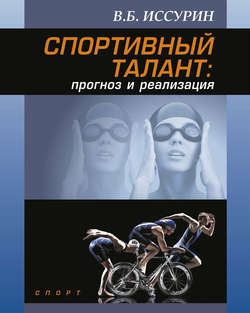Читать книгу Спортивный талант: прогноз и реализация - В. Б. Иссурин - Страница 12
Раздел 1. Спортивный талант: научное обоснование
Глава 1. Талант: общий обзор
Литература к главе 1
ОглавлениеCarroll, J. B. (1993). Human cognitive abilities: A survey of factor-analytic studies. Cambridge, UK: Cambridge University Press.
Colombo, J. (1993). Infant cognition: predicting later intellectual functioning. SAGE Publications Inc.
Ericsson, K. A., Krampe, R.Th. & Tesch-Romer, C. (1993). The role of deliberate practice in the acquisition of expert performance. Psychological Review; 100: 363-406.
Ericsson, K. A. (1998). The scientific study of expert levels of performance: General implications for optimal learning and creativity. High Ability Studies; 9: 75-100.
Eysenck, H. J. (1995). Genius: The natural history of creativity. Cambridge University Press.
Gagne, F. (1993). Constructs and models pertaining to exceptional human abilities. In: International handbook of research and development of giftedness and talent. In: K.A. Heller, F.J. Mönks & A.H. Passow (Editors). Pergamon Press.
Gagné, F. (2005). From gifts to talents: The DMGT as a developmental model. In R.J. Sternberg & J.E. Davidson (Editors), Conceptions of giftedness (2nd ed., pp. 98-120). Cambridge, UK: Cambridge University Press.
Gustin, W. C. (1985). The development of exceptional research mathematicians. In: Bloom, B.S. (editor). Developing talent in young people. Ballantine.
Howe, M., Davidson, J., Sloboda, J. (1998). Innate talents: Reality or myth? Behavioral and Brain Sciences; 21(3): 339-407.
Feldman, D. H., Goldsmith, L. (1986). Nature’s gambit: Child prodigies and the development of human potential. Basic Books/Teachers College Press.
Fisher, P., Turic, D., Williams, N. (1999). DNA Pooling identifies QTLs on chromosome 4 for general cognitive ability in children. Human Molecular Genetics; 8 (5): 915-922.
Freeman, J. (1990). The intellectually gifted adolescent. In: Howe, M. (editor) Encouraging the development of exceptional skills and talents. British Psychological Society.
Kasfir, S. L. (2007). African art and the colonial encounter: inventing a global commodity. Indiana University Press.
Lidor, R., Côté, J., Hackfort, D. (2009). ISSP position stand: to test or not to test? The use of physical skill tests in talent detection and in early phases of sport development. Intern J Sport Exerc Psychol; 7(2): 131-46.
Manturzewska, M. (1986). Musical talent in the light of biographical research. In: Musikalische Begabung finden und förden. Bosse.
Plomin, R., Owen, M.J., McGuffin, P. (1994). The genetic basis of complex human behaviors. Science; 264: 1733-39.
Rutter, M. (1998). What can we learn from highly developed special skills? Behavioral and Brain Sciences; 21 (3): 422-23.
Schlaug, G., Jancke, L., Huang, Y. et al. (1995) In vivo evidence of structural brain asymmetry in musicians. Science; 267: 699-701.
Simonton, D. K. (1999). Talent and its development: an emergenic and epigenetic model. Psychological Review; 106 (3): 435-457.
Sloan, K. D., Sosniak, L.A. (1985). The development of accomplished sculptors. In: Developing talent in young people, ed. B.S. Bloom. Ballantine.
Sloboda, J. A., Davidson, J.W., Howe, M.J.A. et al. (1996). The role of practice in the development of performing musicians. British Journal of Psychology; 87: 287-309.
Tesch-Romer, C. (1998). Attributed talent is a powerful myth. Behavioral and Brain Sciences; 21 (3): 427.
Theusch, E., Basu, A., Gitschier, J. (2009). Genome-wide study of families with absolute pitch reveals linkage to 8q24.21 and locus heterogeneity. The American Journal of Human Genetics; 85: 112-119.
Zohar, A. (1998). Individual differences in some special abilities are genetically influenced. Behavioral and Brain Sciences; 21(3): 431-32.
